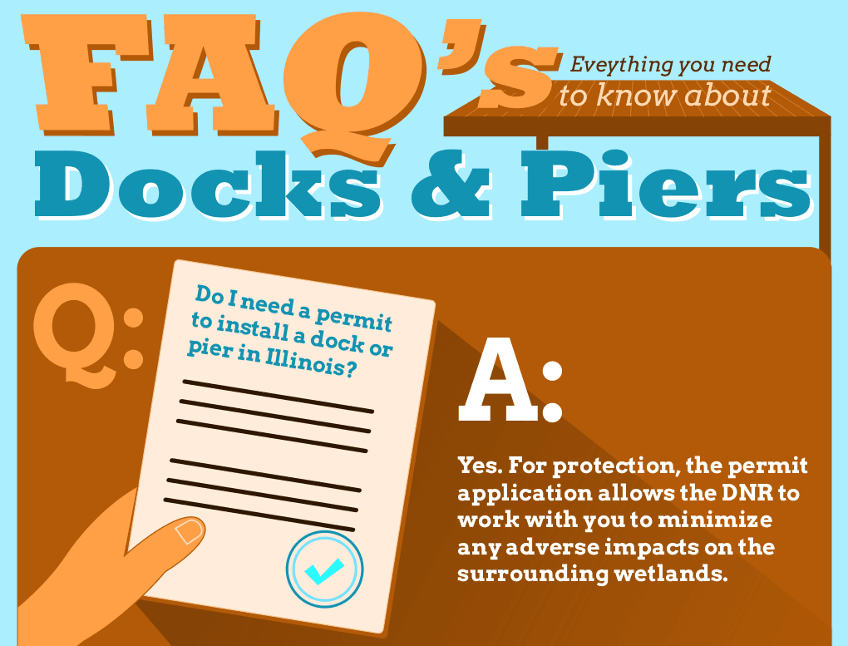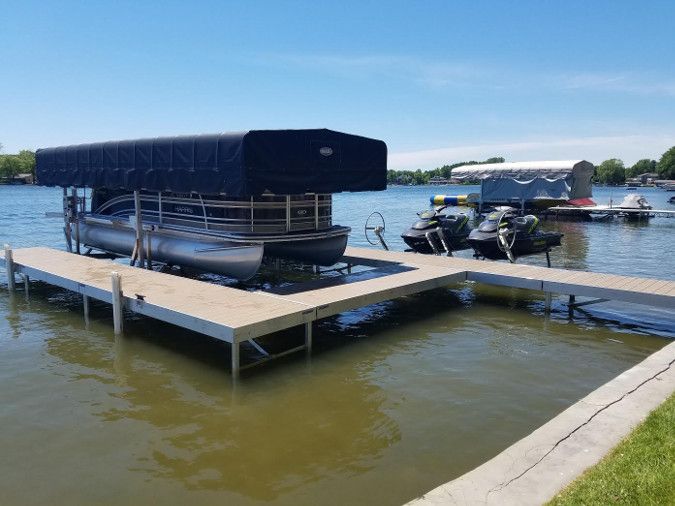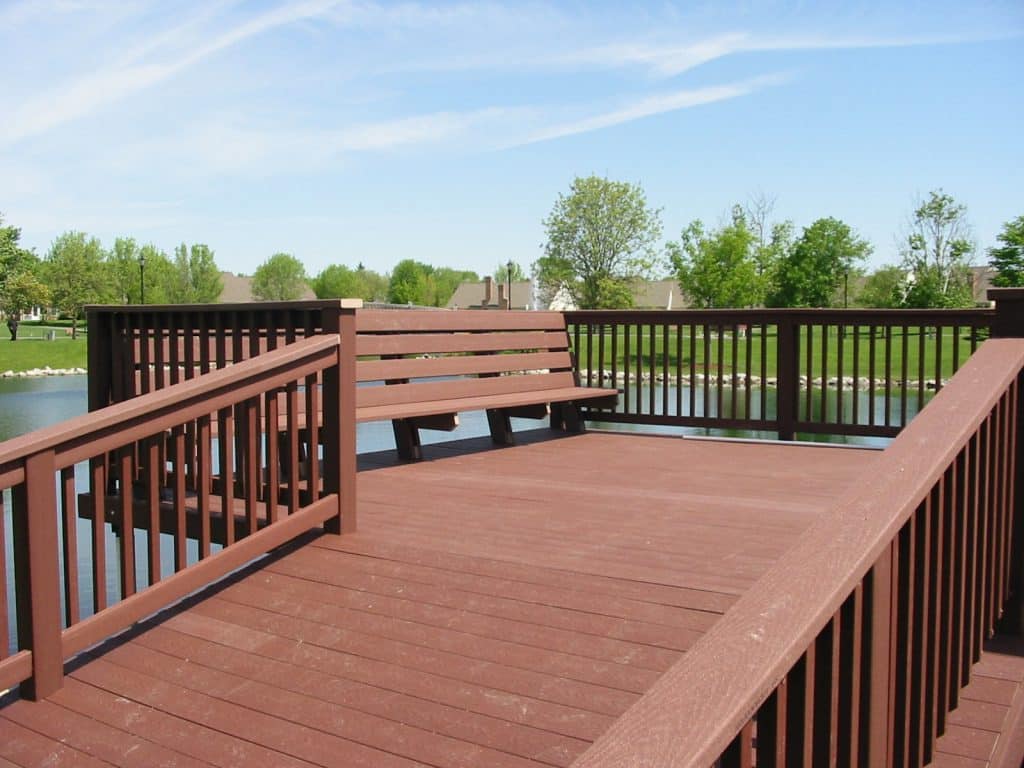Discover the Facts About Dock and Pier Maintenance, Materials, and More!
If you’re a boat owner, you enjoy being out on the water, relaxing and having a great time. You also probably want to know how to keep your dock and pier shipshape. However, you probably don’t want to spend a ton of time on maintenance.
That’s where Captain Rod’s Boat Lift and Pier Services comes in! Let us help you get your dock ready quickly so that you can enjoy your time on the water.
Here are answers to our most frequently asked dock and pier questions as well as links to further resources.
Q: Do I Need a Permit to Install a Dock and Pier in Illinois?
A: Yes. According to the Illinois Department of Natural Resources, anyone planning to install a new dock, boat house, or pier must acquire a permit from the Division of Water Resource Management.
The law was enacted over 50 years ago to protect commerce, navigation, and recreation as well as habitats and reproduction areas for plants, fish, and wildlife. The permit application allows the DNR to work with you to minimize any adverse impacts on the surrounding wetlands.
Q: What Different Kinds of Docks Are There?
A: We differentiate piers based on fixed vs. floating, choice of building materials, and shape. The first decision to make is whether you want a fixed pier or a floating pier. Floating piers float on top of the water, whereas a fixed pier is stuck in place.
Permanent piers can be installed over the winter months and be ready when spring arrives. These piers save time and money on annual removal fees because they don’t need to be removed. Once the structure is in place, we can lay your choice of decking.
If you are putting down roots in a new home and are planning to stick around for the long haul, installing a permanent pier may be the best solution for you.
If your area has a wide tidal range, however, consider a floating pier. Changing tides could lead to your boat rolling and getting damaged while tied up to a fixed pier.
The three main materials to consider for a dock and pier are aluminum, vinyl, and wood.
Building Materials
Anodized aluminum won’t rust and is an extremely resilient and low-maintenance material. Vinyl is inexpensive, water-resistant, and easily provides an anti-slip surface for safer footing. Pressure-treated wood has a wide variety of finishes and is water resistant but can become vulnerable to wood rot.
Shape
Finally, the shape of your pier depends on the shoreline where you’re installing it. Extend it further offshore if there’s a wider tidal range, so your boat doesn’t get damaged by shallows. If the waterway is busy or crowded, you may want a shorter “finger” pier.
Q: Do I Need to Remove My Dock Before Winter?
A: If you live in a warmer climate, and do not feel the harsh effects of winter, you do not need to remove your dock and pier before winter. However, for all you northern-lake-lovers, the answer is probably yes.
Because the lake water will freeze during the winter, the ice will expand and impact your dock. This leaves you with several options, depending on the type of dock you own and the conditions in your area.
One option is to use a de-icer. This is a device that keeps ice from forming near and scraping against your pier. There are two varieties: ice eaters, which propel warmer water up from the depths, and bubblers, which use bubbles to prevent ice formation.
The other option is pier removal. While some docks are permanent, many others are removable. Come winter, professionals from Captain Rod’s can come by and uninstall your pier for the duration of the season. Pier removal prevents ice floes and other winter elements from damaging your dock. Then, in spring, we reinstall your pier so you can get back in the water.
Q: Do Piers Need Frequent, Inconvenient, or Expensive Repairs?
A: Many dock components require periodic upkeep. Smaller parts, rather than the overall deck, typically require the most attention.
In some cases, you won’t know an area needs repair unless you know what to look for. Weather conditions, warping, rust, and dry rot are common issues that occur when docks and piers are in the water year-round. Take a look at the following parts and note the condition of each.
- Rope
- Barrels
- Posts and metal pipes
- Boat bumpers
- Boat lifts
- Roofing
If you find hazardous issues with your dock, call Captain Rod’s Boat Lift and Pier Services right away.
Wooden Parts
A lot of piers are built with wood. Unfortunately, wood deteriorates with time. Maintain it well, if you want it to last.
Check often for signs that the dock needs work. Inspect the wood. Ensure it is properly sealed. Clean the dock with a pressure washer and chemicals at least once a year to remove mold and algae. Sand the wood to get rid of any peeling paint as well as debris that would keep the sealant from sticking to the wood. Last but not least, apply the dock sealant.
You should also use marine putty to patch any punctures or cracks in the wooden platforms. For damage to large areas, epoxy putty works best. When filling pinholes and small scratches, acrylic putty is best.
Also keep an eye out for dry rot. It can cost hundreds of dollars to replace rotted out wooden beams and other parts.
Support Systems
The support structure keeps the dock stable. It’s essential that your pier repair inspection include a look at this system to make sure everything’s in working order.
For example, a floating dock may be held in place with barrels and chains. Check the buoyancy of the barrels and replace them if you need to. Make sure the chains that hold the barrels together or anchor the dock in place are all well-lubricated and weld any breaks together.
You should also keep an eye out for missing screws. These small parts often fall off piers. When they’re missing, you may have loose boards and other problems. Be thorough: check the bottom, sides, and top of the boat dock to see if screws are missing.
Electrical Work
Last but not least, we have pier repair’s electrical component.
You may have equipped your dock with a boat lift or lights that help boaters see at night. It may also feature outlets for pressure washers and other equipment.
These systems require a supply of electricity to power them. If there’s an electrical issue, it’s not just a matter of convenience, it’s a matter of safety. Electrical current running through your dock may even shock you if you have stray voltage and metal platforms. Be careful!
Don’t tackle electrical issues on your own. This calls for a visit from a well-trained and well-equipped expert. The expert in question: one of the qualified professionals from Captain Rod’s Boat Lift & Pier Services. Our technicians have been installing and repairing piers for over 15 years—so leave the electrical issues to them!
Q: Can I Keep My Boat Tied to the Pier?
A: This depends on a number of factors such as lake conditions, size of the boat, and the dock you’re using. Is your body of water smaller, with not much turbulence? Then you’re probably fine leaving your boat tied to the deck.
However, if you have a large, heavy boat, it’s not a good idea to leave it tied to the dock for a long period of time. That would be like chaining a bear to a stop sign. Since the bear outweighs the pole, it would have no problem pulling it loose and getting away. Now, if you have a much stronger, permanent-style dock you may get away with a bigger boat tied up to it.
Many docks are relatively lightweight and will end up tipping over due to the weight of a larger boat.
Bring Your Dock and Pier Questions to Us
Whether you’re thinking about installing a dock or need help maintaining a dock or pier, call Captain Rod’s Boat Lift & Pier Services today at (815) 759-9134. We’re conveniently located in McHenry, IL, in the Chicago area and are eager to answer your questions or set up a consultation.
Editor’s note: This blog was originally published on July 19, 2016 and was updated on August 9, 2019.




